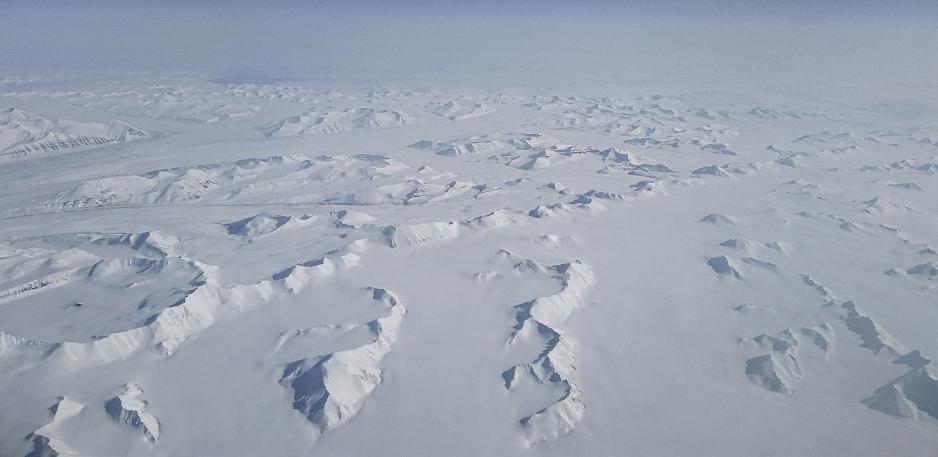Natural Variability Boosts Arctic Warming, Says Researchers

Aerial photo of the Svalbard ice cap. (Source: Os Putos under CC BY-NC-ND 2.0)
When it comes to the Arctic and climate change, it is well known that the region is warming nearly four times faster than the global average. This is a development seen over the past four decades, but recent research now shows that this is not a permanent ratio and that it is likely due to a temporary anomaly.
One can rarely read about climate change and the Arctic without hearing that the region is warming up to four times faster than the global average.
Researchers now believe that this fourfold rate of warming is boosted by natural climate variability and anthropogenic climate change and that the ratio will likely go down to a threefold rate as part of natural variability.
Researcher Mika Rantanen at the Finnish Meteorological Institute. (Photo: Private)
Researcher Mika Rantanen at the Finnish Meteorological Institute in Helsinki was one of the eight researchers who could reveal this fourfold rate in the 2022 research article "The Arctic has warmed nearly four times faster than the globe since 1979."
Now, new research shows that the four times faster warming in the Arctic is a temporary anomaly boosted by natural variability.
Arctic amplification
Arctic amplification (AA) has become one of the most significant effects of human-induced climate change. Arctic implication is the phenomenon that any change in the net radiation balance tends to produce a bigger change in temperature near the poles than in the planetary average.
Mika Rantanen says to High North News that Arctic amplification is defined as a ratio between Arctic warming rate and global warming rate.
"If Arctic warming rate weakens or global warming rate strengthens, or both, they act to lower the Arctic amplification. The magnitude of AA also depends on the time period for which the temperature trends are calculated. We used 43-year temperature trends, but as shown in our paper, the ratio is closer to three when calculated over 50 years, for example," he says.
It had previously been thought that the Arctic was warming 2-3 times faster than the global average. However, a study from 2022 showed that Arctic amplification has been taking place at a speed four times faster than the rest of the globe in the past four decades (between 1979 and 2021).
This research did not take a position on whether this was a permanent state of Arctic warming. Now, new research shows that it is not.
Natural variability
Rantanen explains that natural variability has boosted Arctic warming and that the fourfold rate is not only human-induced.
"There is natural variability in both Arctic and global warming trends (probably more in the Arctic trend), which affects the ratio between these two. For example, the Arctic has experienced rapid warming in recent decades due to favorable changes in atmospheric circulation. This has boosted the warming, on top of the human-induced climate change," the researcher states.
"In our paper, the AA was calculated for the 1979-2021 time period. Recently, the year 2023 was the warmest on record globally, but only the 7th-8th warmest in the Arctic. This acts to lower the Arctic warming trend and strengthen the global warming rate, which reduces AA."
Is Arctic amplification (at the rate of two to three times as fast as the global rate) a permanent state?
"Yes, a recent study found that about 3-fold warming rate is the *forced* amplification ratio which results in human-induced climate change."
"In the future, the observed AA may vary around this forced value (three), and it can go even below three, if there are decades of weakened warming in the Arctic due to unfavorable atmospheric circulation (or accelerated global warming)."
A decrease in Arctic warming
Rantanen says that AA has already started to reduce after the four decades of fourfold Arctic warming.
Is it possible to say something about when this fourfold Arctic warming will decrease? And what will Arctic amplification be like at that point?
"We calculated AA for the 1979-2021 period, and got a result of 3.7-fold warming in the Arctic relative to global warming. Now when I repeated the calculation for two years later period, 1981-2023, the number is 3.4. So it is already evident that AA has peaked and the amplification has slightly reduced. But again, the absolute numbers depend on how long time periods are chosen. Here I used 43-year ratios as was done in our paper. In the future I expect that AA will be around three as stated in Zhou et al. paper," says Rantanen.





